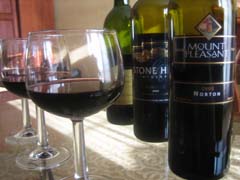Road Trip: Mid-America
By John ~ May 23rd, 2008.
In recent weeks, we’ve reported from the road on winery visits in California, Arizona, New Mexico, Texas, Tennessee and Kentucky. Today, I’ll report on our wine tasting visits in Ohio, Wisconsin, Missouri, and Nebraska.
On the way out of Cincinnati, Ohio, we stopped at Ohio’s oldest and largest winery, Meier’s Wine Cellars. It was almost a replay of the wineries we visited in Tennessee, meaning that Ohio is not serious premium wine country. As the tasting room hostess explained, their customer base likes sweet, fruity wines so that is what they produce. We did our best to smile and taste about a half dozen of their selections, but there wasn’t anything I would write home about, so I won’t.
In Wisconsin, between Milwaukee and Green Bay, we stopped in the old historic town of Cedarburg to visit the Cedar Creek Winery. It was a fun visit in their tasting room because of the knowledge and friendliness of the tasting room hostess. While Cedar Creek and their sister winery produce a total of over 80,000 cases per year, it is virtually all sold in the state of Wisconsin. They can and do ship to about twelve states, but Washington is no longer one they can ship to, even though five of the wines they make are produced with Washington grapes. Sounds familiar, doesn’t it? Washington is happy to let them buy grapes but not to sell back wine produced with those grapes to consumers in Washington State. Once again, Washington’s reputation is suffering from these kinds of nonsensical rules.
While none of the wines we tasted made from Wisconsin grapes were outstanding, several were pleasant sipping wines at very reasonable prices that I would have purchased if they could ship to Washington. The visit was not all for naught because I was able to add several grape varieties to my Wine Century Club list: Seyval Blanc (white), Lacrosse (red), and St. Pepin (red).
In Branson, Missouri, we visited three wine tasting rooms to get a flavor for Missouri wines. While Missouri is primarily a sweet wine state, as have been most mid-America states, they do produce some decent dry wines as well. The most notable is Norton, a dry red varietal native to Missouri.
Our first stop was at the Lindwedel Wine Garden. We found out that Lindwedel is actually a wine retailer, not a producer, but they do sell several wines under their own label, the NV Lindwedel Norton and the NV Lindwedel Norton Port.
Next we visited the Stone Hill Winery tasting room. Stone Hill is one of Missouri’s oldest and largest wineries. We thought their best wine was a 2004 Stone Hill Norton. Other wines we tasted were a 2005 Stone Hill Port, a 2006 Stone Hill Chardonel (Chardonnay/Seyval Blanc blend), a 2005 Stone Hill Chambourcin, and a NV Stone Hill Cream Sherry.
 Our third and final stop of the day was at Mount Pleasant Winery, a new and obviously well-funded operation out of Augusta, Missouri. Their Branson tasting room has only been open five weeks, but is it clear that they intend to be a serious player in the premium wine business in Missouri. I’d like to come back in five years and see what they have accomplished. They appear to be one of the few Missouri wineries having any success growing the traditional reds like Cabernet Sauvignon and Merlot.
Our third and final stop of the day was at Mount Pleasant Winery, a new and obviously well-funded operation out of Augusta, Missouri. Their Branson tasting room has only been open five weeks, but is it clear that they intend to be a serious player in the premium wine business in Missouri. I’d like to come back in five years and see what they have accomplished. They appear to be one of the few Missouri wineries having any success growing the traditional reds like Cabernet Sauvignon and Merlot.
Our favorite of their wines was the NV Mount Pleasant Tawny Port. We also liked their 2001 Mount Pleasant Vintage Port and their 2005 Mount Pleasant Norton, although the Norton appears overpriced at $35. Other Mount Pleasant wines we tasted were the 2004 Mount Pleasant Cabernet Sauvignon, the 2004 Mount Pleasant Claret, and the NV Mount Pleasant Villagio (white blend).
 The night after we visited the wineries we got a take-out pizza for dinner and took it back to our room to have a private tasting of three Missouri Norton wines. We blind tasted the NV Lindwedel Norton, the 2004 Stone Hill Norton, and the 2005 Mount Pleasant Norton. We easily agreed that the Mount Pleasant was our favorite, the Lindwedel was our second choice, and the Stone Hill came in third. This pretty well verified our preliminary rankings when we visited each of the wineries.
The night after we visited the wineries we got a take-out pizza for dinner and took it back to our room to have a private tasting of three Missouri Norton wines. We blind tasted the NV Lindwedel Norton, the 2004 Stone Hill Norton, and the 2005 Mount Pleasant Norton. We easily agreed that the Mount Pleasant was our favorite, the Lindwedel was our second choice, and the Stone Hill came in third. This pretty well verified our preliminary rankings when we visited each of the wineries.
From our limited sampling of Missouri wines, it seems apparent that while Missouri has traditionally had a sweet and fruit wine emphasis geared toward tourists, there are now serious vintners trying to develop a premium wine industry with traditional grapes as well as the notable local grapes such as Norton.
 From Missouri, we drove up to Nebraska and visited Nebraska’s largest winery, James Arthur Vineyards in Raymond, Nebraska. We tasted six of their dry red wines, all made from Nebraska grown grapes. None of their wines were from traditional varietals because of their cold northern location and short growing season. Although I did not classify any of their offerings as outstanding, two were pretty good, and we did add three new varieties to our Wine Century Club list: De Chaunac, Frontenac, and St. Croix.
From Missouri, we drove up to Nebraska and visited Nebraska’s largest winery, James Arthur Vineyards in Raymond, Nebraska. We tasted six of their dry red wines, all made from Nebraska grown grapes. None of their wines were from traditional varietals because of their cold northern location and short growing season. Although I did not classify any of their offerings as outstanding, two were pretty good, and we did add three new varieties to our Wine Century Club list: De Chaunac, Frontenac, and St. Croix.
Their best wine was a 2005 James Arthur St. Croix. Other wines we tasted were the 2006 James Arthur Frontenac, the NV James Arthur Reserve Rouge (St. Croix/St. Vincent blend), the NV James Arthur Nebraska Red (St. Croix/ St. Vincent/Foch blend), the 2006 James Arthur Game Bird Red (St. Vincent), and 2005 James Arthur De Chaunac.
Out of the four mid-America states in which we sampled wines (Ohio, Wisconsin, Missouri, and Nebraska), Missouri appears to be the most serious about premium wine production and the state with the most overall wine potential.
In order to keep these notes from being unwieldy as we tasted many different wines, I have broken down the list into Quality rating categories. Under each Quality heading, the wine name will be listed along with state, price and QPR rating. Wines in bold type received a QPR rating of 5 bangs for your buck (out of 5).
Quality: 4 stars (out of 5)
NV Mount Pleasant Tawny Port, Missouri, $30, QPR: 5
Quality: 3.5 stars (out of 5)
2001 Mount Pleasant Vintage Port, Missouri, $25, QPR: 5
NV Lindwedel Norton, Missouri, $22, QPR: 4
2005 Mount Pleasant Norton, Missouri, $35, QPR: 1
Quality: 3 stars (out of 5)
2005 Stone Hill Port, Missouri, $20, QPR: 5
NV Lindwedel Norton Port, Missouri, $25, QPR: 4
2004 Stone Hill Norton, Missouri, $19, QPR: 3
2004 Mount Pleasant Cabernet Sauvignon, Missouri, $40, QPR: 3
2005 James Arthur St. Croix, Nebraska, $17, QPR: 1
2006 James Arthur Frontenac, Nebraska, $15, QPR: 1
Quality: 2.5 stars (out of 5)
2006 Stone Hill Chardonel, Missouri, $11, QPR: NR
2005 Stone Hill Chambourcin, Missouri, $16, QPR: NR
NV Stone Hill Cream Sherry, Missouri, $16, QPR: NR
2004 Mount Pleasant Claret, Missouri, $19, QPR: NR
NV James Arthur Reserve Rouge, Nebraska, $14, QPR: NR
NV James Arthur Nebraska Red, Nebraska, $14, QPR: NR
Quality: 2 stars (out of 5)
NV Mount Pleasant Villagio, Missouri, $12, QPR: NR
2006 James Arthur Game Bird Red, Nebraska, $15, QPR: NR
Quality: 1.5 stars (out of 5)
2005 James Arthur De Chaunac, Nebraska, $12, QPR: NR
Filed under: American Wine, Cabernet Sauvignon, Dessert Wine, Five-Bangs For Your Buck Wines, Lesser Known Varietals, Missouri Wine, Nebraska Wine, Norton, Ohio Wine, Port, Red Wine, White Wine, Wine Century Club, Wine Travel, Wines NOT To Buy (1 & 2 Star), Wines Over $25, Wines Under $15, Wines Under $20, Wines Under $25, Wisconsin Wine

 Wine Peeps is an independent wine blog dedicated to helping you get the most bang for your buck in wine. We do this through blind tastings of wine from around the world and calculations of
Wine Peeps is an independent wine blog dedicated to helping you get the most bang for your buck in wine. We do this through blind tastings of wine from around the world and calculations of 











Ohio actually has some really good wines – Meiers may be old, but they are a poor representation of wineries in Ohio. Next time you’re here, I highly recommend trying Henke Winery. Really outstanding wines without the emphasis on the sweet fruity stuff!
http://www.henkewine.com/
Brenda,
Thanks for the heads-up on Henke. I’ll try to check them out on my next visit to Ohio.
Glad you’re tasting and writing about Ohio wines. Please do try to taste some others. Meier’s is not a representative sample. For some suggestions, take a look at OhioWineTV.com
I want to thank Brenda for bringing our winery to your attention. You might be interested in finding out that there are 100 plus wineries, several of the southern Ohio wineries do not emphasize the “pop” wines. To find out more about Ohio Wineries, check the web site, http://www.tasteohiowines.com
We’re looking forward to seeing you the next time you’re in Cincinnati.
You should check out Kinkead Ridge wines. Two Kinkead Ridge wines were rated in the top 100 Exciting Wine Finds in the world by Tom Stevenson, British editor of the New Sotheyby’s wine encyclopedia in England. We only grow vinifera, including Cabernet Sauvignon, Cabernet Franc, Syrah, Viognier, Roussanne, Sauvignon Blanc, Semillon, Petit Verdot and Riesling.
Nancy,
Thanks for you suggestion. If I remember correctly, Kinkead Ridge was not open when we came through Ohio last year. They must not be open year-around? However, I will put them on my list for the next time I’m in Ohio wine country.
Although this blog entry is a couple of years old, I felt compelled to comment, and provide a link.
http://wiswine.org/home
You need to return to Wisconsin, if you haven’t already, and tour more than just one winery. Wisconsin has several, and produces some great-tasting wines.
That is interesting about Ohio. I feel Columbus and Cincinnati are two strong areas that produce wine. Although our vineyards are based out of Napa Valley, California. Robert John vineyards produce an astounding 2009 Cabernet Sauvignon. If you really need to get away from the sweet stuff, get adventurous and really explore Ohio. We would be happy to share our wine with you.
Sincerely,
RJV